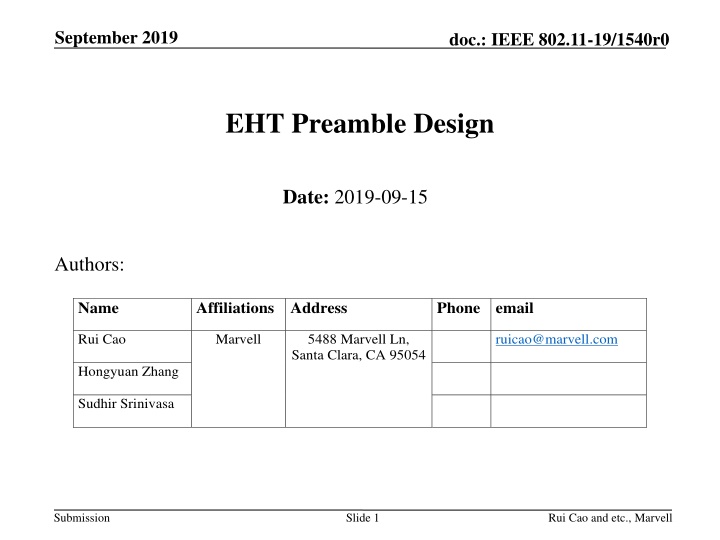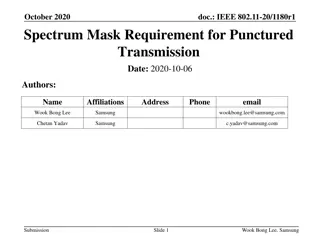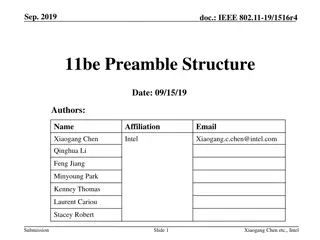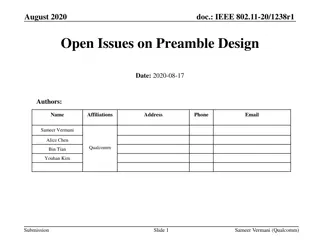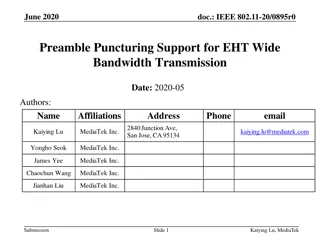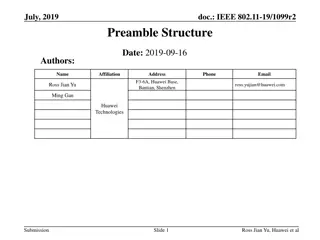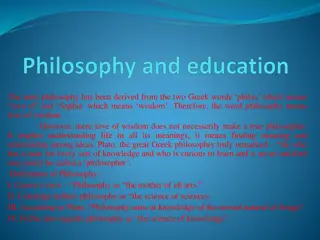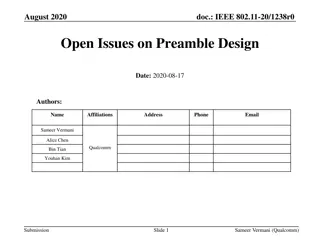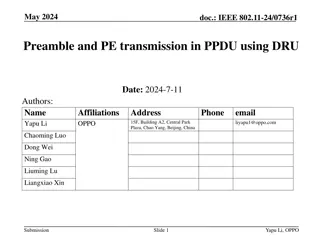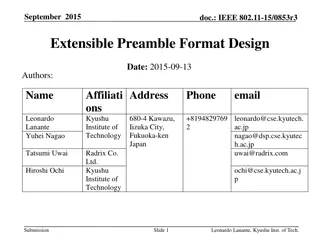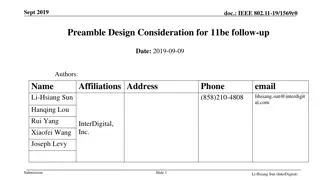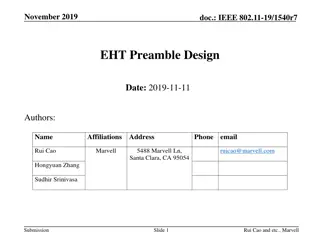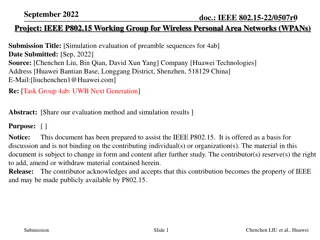Evolution of IEEE 802.11 Preamble Design Philosophy
IEEE 802.11 standards have evolved over the past two decades, and preamble design plays a crucial role in each generation. This document delves into the philosophy behind preamble design, focusing on backward compatibility, auto-detection, and support for various PHY/MAC features. The proposed EHT preamble design aims to create a unified structure for future coexistence, simplifying PPDU format detection and ensuring compatibility across different generations. The high-level preamble structure includes elements such as L-STF, L-LTF, L-SIG, RLSIG, and Common SIG. Additionally, it discusses the importance of Common SIG, which exists in all EHT and future generations, providing resilience to preamble puncturing and defining static bits for signaling co-existence and PPDU formats. The document also introduces a unified two-step PPDU format signaling approach for EHT and beyond, emphasizing implicit signaling in the first step.
Download Presentation

Please find below an Image/Link to download the presentation.
The content on the website is provided AS IS for your information and personal use only. It may not be sold, licensed, or shared on other websites without obtaining consent from the author.If you encounter any issues during the download, it is possible that the publisher has removed the file from their server.
You are allowed to download the files provided on this website for personal or commercial use, subject to the condition that they are used lawfully. All files are the property of their respective owners.
The content on the website is provided AS IS for your information and personal use only. It may not be sold, licensed, or shared on other websites without obtaining consent from the author.
E N D
Presentation Transcript
September 2019 doc.: IEEE 802.11-19/1540r0 EHT Preamble Design Date: 2019-09-15 Authors: Name Affiliations Address Phone email Marvell Rui Cao 5488 Marvell Ln, Santa Clara, CA 95054 ruicao@marvell.com Hongyuan Zhang Sudhir Srinivasa Submission Slide 1 Rui Cao and etc., Marvell
September 2019 doc.: IEEE 802.11-19/1540r0 Introduction 802.11 standards have evolved from 802.11a to 802.11ax over past two decades. Preamble design is important in each generation. Provide backward compatibility with exiting standards. Enable PPDU format auto-detection. Signal important information to support various PHY/MAC features. From EHT, we propose to advance the preamble design philosophy to support an unified structure enabling future coexistence and simple PPDU format detection. Submission Slide 2 Rui Cao and etc., Marvell
September 2019 doc.: IEEE 802.11-19/1540r0 EHT Preamble Design Philosophy Till 11ax, the preamble design has piled up features for each PPDU format to support auto-detection. QBPSK, L-LENGTH%3, RL-SIG Auto-detection complexity and latency have significantly increased. Limit complexity in EHT for auto-detection Future compatibility and coexistence Backward compatibility EHT EHT and beyond 11a/g/n/ac/ax Across-generation coexistence using preamble. Mainly L-LENGTH is used across generations for CCA detection. In 11ax, more coexistence bits are added, e.g. BSS color, TXOP, etc. Only understood by 11ax STAs, and different bit definition across PPDU EHT as a switch point to include future coexistence. Submission Slide 3 Rui Cao and etc., Marvell
September 2019 Rui Cao and etc., Marvell doc.: IEEE 802.11-19/1540r0 EHT Preamble Structure L-STF L-LTF L-SIG RLSIG Common SIG ;;; EHT-STF, EHT-LTF, EHT-DATA EHT SIG RLSIG L-STF L-LTF L-SIG Common SIG L-STF L-LTF L-SIG RLSIG Common SIG Based on this design philosophy, we discussed high-level EHT preamble structure in our previous contribution [1]. Backward compatible: legacy preamble is appended RLSIG: kept for range extension and PPDU format signaling Common SIG field Static bits are common across generations, signaling co-existence bits. Includes bits to indicate PPDU formats EHT-SIG field Signal other PPDU decoding related information, MU info, etc. Submission 4
Rui Cao and etc., Marvell doc.: IEEE 802.11-19/1540r0 Common SIG Common SIG exists in all EHT and future generations Defined on 20MHz bandwidth, similar to HE-SIGA. Duplicated over entire PPDU bandwidth. Resilient to preamble puncturing Static Bits Fixed location and bit definition across all future generations. Example: BSS color, TXOP, PHY format bits, etc.. PPDU format bits may include in other portion of Common SIG, can be generation specific. Submission 5
September 2019 Rui Cao and etc., Marvell doc.: IEEE 802.11-19/1540r0 PPDU Format Signaling Unified two-step PPDU format signaling for EHT and beyond. Step 1: Implicit signaling of EHT and beyond PPDU One bit information whether the PPDU is EHT and beyond E.g. LENGTH%3, RLSIG, QBPSK and etc. Need to be simple and robust Auto-detection complexity is limited to design of this part. Step 2: Explicit signaling of specific PPDU format Use PHY format bits and PPDU bits in Common SIG symbols to signal PPDU formats. Submission 6
September 2019 Rui Cao and etc., Marvell doc.: IEEE 802.11-19/1540r0 EHT and beyond PPDU Identifier Design criterion: Limited complexity and latency. Detect EHT and beyond PPDU format as early as possible. Sufficient time for AGC, enable power saving, etc. The minimum amount of change to 11ax to limit complexity. Reduce the amount of hypothesis in the classification state-machine Proposed design: LENGTH%3 == 0 + RL-SIG + BPSK Common SIG1 Same complexity level and detection latency as 11ax. Simple modification in the logic to detect EHT PPDU. Mature design endorsed by existing 11ax STAs. Submission 7
September 2019 doc.: IEEE 802.11-19/1540r0 EHT SIG EHT SIG contains all PPDU-dependent signaling bits that are not included in Common SIG field. To simplify EHT SIG design, EHT SIG may use unified structure for all formats. The detailed structure of EHT SIG structure is TBD. Submission Slide 8 Rui Cao and etc., Marvell
September 2019 doc.: IEEE 802.11-19/1540r0 Summary EHT preamble can be a pivoting generation to support future coexistence. Define Common SIG with Static Bits to coexist with future generations. Two-step PPDU format classification for EHT and beyond LENGTH%3 == 0 + RLSIG + BPSK Common SIG1 PPDU bits in Common SIG. Submission Slide 9 Rui Cao and etc., Marvell
September 2019 doc.: IEEE 802.11-19/1540r0 Reference [1] High-level EHT Preamble Structure, IEEE 11-19/1085. Submission Slide 10 Rui Cao and etc., Marvell
September 2019 doc.: IEEE 802.11-19/1540r0 SP1 Do you agree the following EHT preamble structure? Pre-append with L-STF + L-LTF + L-SIG + RL-SIG The next field after RL-SIG is modulated on 20MHz basis, number of symbols TBD L-STF L-LTF L-SIG RLSIG Common SIG ;;; RLSIG L-STF L-LTF L-SIG Common SIG L-STF L-LTF L-SIG RLSIG Common SIG Submission Slide 11 Rui Cao and etc., Marvell
September 2019 doc.: IEEE 802.11-19/1540r0 SP2 Do you agree that EHT and beyond PPDU format is classified by the following combination? LENGTH%3 == 0 + RL-SIG + BPSK on next symbol Y: N: A: Submission Slide 12 Rui Cao and etc., Marvell
September 2019 doc.: IEEE 802.11-19/1540r0 Reference [1] EHT Preamble Design, Marvell Submission Slide 13 Rui Cao and etc., Marvell
September 2019 Rui Cao and etc., Marvell doc.: IEEE 802.11-19/1540r0 Appendix: Existing PPDU Formats L-STF L-LTF L-SIG L-DATA 11a HT-MM HT-LTFs HT-DATA L-STF L-LTF L-SIG HTSIG1 HTSIG2 HT-STF HT-GF HT-GF-STF HT-LTF1 HTSIG1 HTSIG2 HTLTF2~NLTF HT-DATA VHT VHTLTFs VHTSIGB VHT-DATA L-STF L-LTF L-SIG VHTSIGA1 VHTSIGA2 VHTSTF L-STF L-LTF L-SIG RLSIG HE-SIGA1 HE-SIGA2 HE-SIGB, HE-STF, HE-LTF, HE-DATA HE SU/MU L-STF L-LTF L-SIG RLSIG HE-SIGA1 HE-SIGA2 HE-SIGA, HE-SIGB, HE-STF, HE-LTF, HE-DATA HE_ER QBPSK BPSK HT-GF: Third symbol QBPSK detection can classify. HT-MM: LENGTH%3 == 0 + SIG1 QBPSK (+ SIG2 QBPSK) can classify VHT: LENGTH%3 == 0 + SIGA1 BPSK + SIGA2 QBPSK HE SU/MU: LENGTH%3 ~= 0 + RLSIG + SIGA1 BPSK + SIGA2 BPSK HE ER SU: LENGTH%3 ~= 0 + RLSIG + SIGA1 BPSK + SIGA2 QBPSK Submission 14
